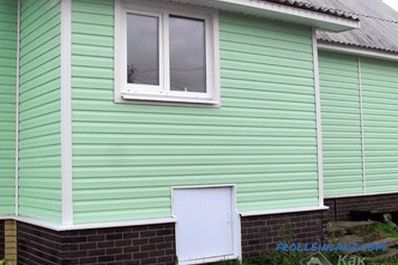Marshy soils are subject to seasonal fluctuations to a greater degree than all the others. They are oversaturated with fine particles and therefore often form fluids. In the winter, they freeze and swell, in the spring - they are washed out when the groundwater rises. Putting the foundation in the swamp with your own hands is a difficult task, but completely solvable. The main thing is to study the soil and correctly choose the type of support and the depth of its foundation.
Preliminary works
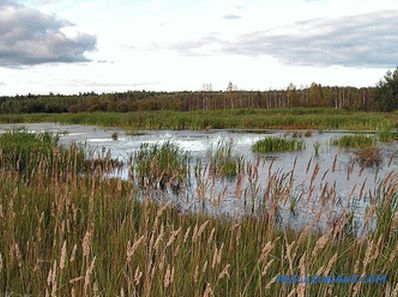 Soil tests
Soil tests
It is imperative to establish the composition of the soil and its change at different horizons, as well as determine the occurrence of water carriers and assess the terrain. You can do the research yourself, but it is better to involve specialists in this. To analyze the soil content, it is necessary to drill several wells at different points, or to dig holes.
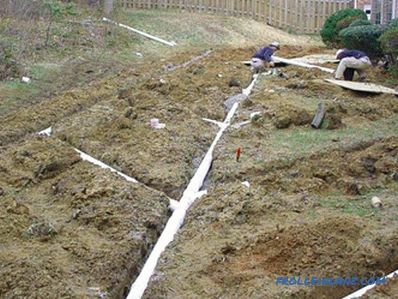 Drainage of the area
Drainage of the area
If the soil is not very swampy, it is enough to drain the area to avoid flooding the future buildings.
In some cases, the thickness of the peaty layer is small and can be simply removed. Then the foundation is set on a stable rock, which is located below. His view is taking into account other technological or financial considerations.
In other cases, you have to choose from two options:
- pile foundation;
- monolithic slab.
The project is finally approved, taking into account the structure of the structure and the total pressure on the base.
How to build a foundation in the swamp
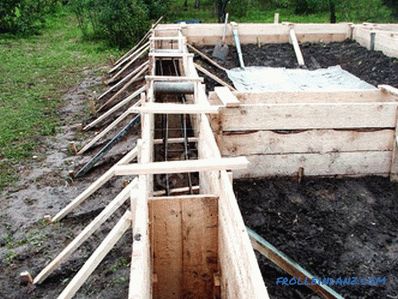 Base construction in the swamp
Base construction in the swamp
Pile foundation allows you to go through unstable layers and rely on reliable soil that can hold large loads.
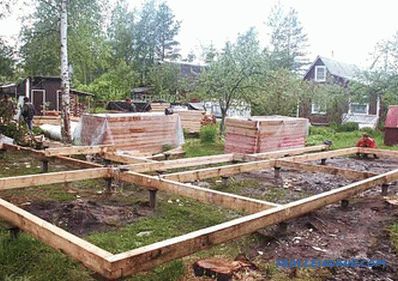 Pile foundation in the swamp
Pile foundation in the swamp
Usually, several types of piles are used for the construction:
- Metal screw. Not too durable, because in an acidic environment iron will quickly oxidize;
- Zabivny. Their installation is expensive and requires the use of construction equipment, but its access to the site may be difficult; 32> Bored. Installed on pre-drained soil. Creating a foundation using such piles involves a large amount of work, and is also expensive.
Whatever type of support you choose, a grillage is constructed above them. For wetlands it is made in the form of reinforced concrete floors.
The monolithic slab foundation is a universal remedy for the construction of a pillar of the house in swampy areas. It is expensive, but it is quite reliable. The base turns floating, and a large footprint distributes the load well from all sides. This avoids deformations of the building and its individual elements.
How to make a slab foundation
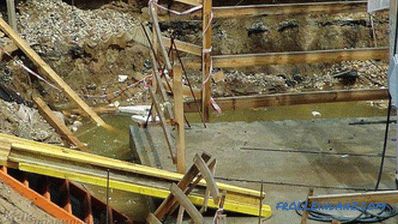 Monolithic foundation
Monolithic foundation
Step No. one. Before pouring the slab, you need to prepare the soil under it. The top layer is removed by about a meter and a pad of gravel, stones and sand is poured. Sometimes it is partially replaced with construction debris. Everything is thoroughly wetted and rammed. Such a sand-gravel bedding allows groundwater to move under the sole, without stopping, and swell less in winter.
Step # 2. A thin layer of cement mixture is spread over the pillow as a substrate. It should smooth the rubble surface. In 48 hours it will dry up and then it will be possible to put insulation. Typically, for this purpose, use foamboard or polystyrene foam plates with a thickness of 10 cm.
Step No. 3. Several rows of coarse waterproofing, for example, roofing felt, are laid on top. It will not allow soil moisture through the capillaries to be absorbed into the concrete base. It is even better to use polymer diffusion membranes. They not only protect the concrete from the bottom of the water, but also at the expense of vapor-permeable properties, they remove moisture from it.
Step # 4. The formwork is being installed. Removable fencing is assembled from boards, fastened with nails, but you can use fixed sheets of foam, which will simultaneously become insulation.
Step # 5. The reinforcement for the foundation in the swamp should be selected with increased strength, with the diameter of the rods of 12-16 mm. A two-level grid with a cell size of 15x15 cm is formed. The dressings are made with steel wire.
Step # 6. Concrete is poured at a time so that no seams are formed inside that weaken the structure. The solidifying mass is treated with a deep vibrator to remove air from it. In conclusion, the surface is aligned with a vibrating rail. The stove will dry and gain strength for at least a month. To keep the process going evenly, the pad is covered with PVC film and moistened from time to time. The readiness of the foundation can be determined using the same polyethylene: when the condensate on it stops settling - the process is completed.
Step # 7. The formed slab must be protected from moisture on the top and sides by coating with waterproofing. It will close the concrete from freezing and mechanical damage.
With a small budget, building a foundation in a swampy area is very difficult. Even on light and dry soils, casting supports takes between 1/5 and 1/3 of the total cost of a house. Therefore, it is necessary to decide on the type of foundation and building materials before purchasing the land, and for this you need to have complete information about it.
Is your home built on swampy soils? Tell us about its construction and the quality of the foundation, leaving a comment on the article.
Video
We recommend watching a video about the construction of a monolithic foundation on a peat platform.



